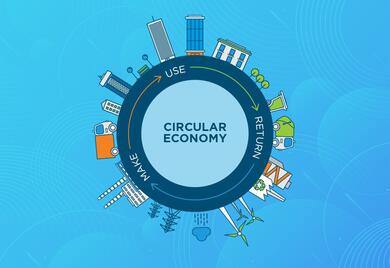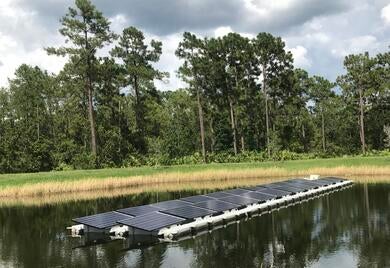
The Case for Unlocking the Circular Economy in Latin America and the Caribbean
Circular economy (CE) presents an opportunity for an inclusive and resource-smart future. It is also a chance for Latin America and the Caribbean to depart from an incremental into a transformative change.

How to Make the Sustainable Development Goals More Meaningful for the Private Sector
After IDB Invest’s Sustainability Week 2019 in June, we distilled some key takeaways for the private sector on the Sustainable Development Goals. Here’s what we found.

Can 'flotovoltaics' be a future partner for hydropower systems?
To address changing paradigms, a new technology has been proposed: hydropower plants that enable solar generation or hybrid hydro-solar systems.

How to Introduce Corporate Governance into Family-Owned Firms?
The most prevalent ownership model in the Latin America and the Caribbean region is, by far, the family-owned firm. By formalizing the different roles of its members, family-owned firms can greatly enhance their sustainability and performance.

Solar energy: The revolution spurring development in Honduras
When Invema plant, the main plastic recycler in Honduras starts operating, a success formula resonates. It is one of the commercial companies that took advantage of the photovoltaic energy boom in the country. Its case demonstrates how the private sector’s investment in solar energy can facilitate greater economic and sustainable development for the country. Six years ago, the executives of the firm decided to install solar panels in the company, so it could generate its own power. This initiative promised a 20% reduction in energy consumption as well as a significant reduction in greenhouse gases emissions of polluting gases. And so it was. Today, Invema obtains energy savings up to 30% in electricity and reinvests in the focus of its business, recycling, so much so that it is now manufacturing the bottles that Coca-Cola uses in Central America. “We are very proud, because thanks to the solar panels, IDB Invest’s doors/channels opened up and allowed us to make the investments we dreamed,” says George Gatlin, the manager of Invema, which is located in the northern city of San Pedro Sula. Invema is part of many companies and private consortia that have opted for photovoltaic energy since Honduras decided to reform its electricity subsector to revert its electricity matrix from thermal to renewable. The reforms began in 2012, when generation using fossil fuels accounted for 70% compared to 30% for renewables. This thermal hegemony was reflected in increasing oil billing, carbon dioxide emissions, high tariffs up to US$0.30 per kilowatt (KW) produced, and frequent rationing. Following the reforms, led by the government with the advisory services of the Inter-American Development Bank (IDB), there was an upsurge in renewable energy until the energy matrix was completely reversed compared to 2012. The latest report from the Central Bank of Honduras (BCH) in 2018 records a 75% electricity generation based on renewable sources, and an 11% share of photovoltaic energy. This percentage translated into 433 megawatts (MW) of installed capacity at the end of 2016, placing Honduras in the lead of solar generation in Central America and third in Latin America, after Chile and Mexico. “We are witnessing a revolution in the electricity sector, not just in Honduras, but worldwide, because energy storage is changing the concept, points out Carlos Jácome, IDB energy specialist who has participated in the reforms process in Honduras. “The Bank support comprises studies and soft financing. Later, the savings make it possible to improve the productivity of these companies because they can use what they no longer pay in energy to expand their businesses,” comments Jácome. Since 2012, the IDB and IDB Invest have provided technical assistance to Honduran commercial, industrial, and institutional sectors to investigate the technical and financial feasibility of photovoltaic projects. To date, 22 studies have been completed for projects ranging from 40 kilowatts (kW) to nearly 3 MW of installed capacity. Official reports indicate that interest in photovoltaic projects have increased due to a reduction in about 40% of the installation costs over the last five years. Behind this innovation there are three combined components that have resulted in a successful formula: i) the impetus of government that created favorable conditions for investment; ii) the decisions made by entrepreneurial companies; and iii) the IDB’s ability to evaluate and finance the projects. The initial investments in photovoltaic development in Honduras involved a shared risk for IDB Invest and its clients. Nonetheless, what made the difference is the technical capabilities of the Bank for evaluating and support for this type of investments. The Honduran experience encourages entrepreneurship and new markets while demonstrating that IDB Invest is the partner of choice for innovative markets. Experiences of this kind should be replicated in the region. The first photovoltaic investments began in 2015, when 388 MW were installed, followed by 45 MV more in 2016, according to reports from the National Electrical Energy Company (ENEE). According to the ENEE, the Honduran commercial and industrial solar energy market is quite different from what it was in 2012, starting with changes in electricity billing (between 11 and 18 cents per kW per hour), installation costs for panels, legal regulations, and the availability of photovoltaic manpower in the region. In addition to this, national capacities have developed with the installation and administration of photovoltaic projects. “Before, if a Canadian, Spaniard or a Costa Rican person did not show up to supervise the project it didn’t move forward. Now the Hondurans themselves have been strengthening all these positions. There is a friendly environment for investment,” notes Elsia Paz, President of the Honduran Renewable Energy Association (EHER), one of the entities that emerged in the context of these reforms. Download the full story here: “Solar Energy: The Revolution Spurring Development in Honduras” Subscribe to receive more content like this! [mc4wp_form]

New ways to increase infrastructure investment
Historically, Latin America has invested 2% to 3% of regional gross domestic product (GDP) per year in infrastructure, even though it should reach at least 5% to meet the region’s needs. This difference creates a gap so large that can only be reduced with both private and public investments participation. What progress has been made to close this gap? Colombia and Chile are the countries with the highest capacity to carry out sustainable Public Private Partnerships (PPPs) in infrastructure in the region, according to the Infrascope. Chile has a long tradition of private participation in infrastructure projects that goes back 25 years. Also, it has a sound regulatory framework supporting PPPs, a solid investment and business climate, and has developed financing instruments. Colombia also enjoys a strong regulatory framework, supported particularly by the 2012 PPP law, and the strength of the institutions in charge of developing and maintaining PPP contracts. In the past five years, Chile and Colombia have awarded 70 and 30 PPP projects, respectively. What can we learn from these countries’ experiences? Colombia and Chile are two examples for the rest of region, especially regarding its regulations and PPPs' maturity, where both countries scored first in the ranking for these two Infrascope’s assessment categories. Colombia, for example, has incorporated the lessons learned from preceding toll road concession programs in the current 4G framework, particularly in the areas of: 1) risk allocation; 2) contracts financial structuring; 3) standardization of technical studies, financial models and methodologies to value risk; 4) streamlining and standardization of contracts; and 5) improvement of bankability, through the inclusion of lenders’ step-in rights and dispute resolution provisions; among others, according to a recent report from the Inter-American Development Bank (IDB). [clickToTweet tweet="Latin America needs to invest 5% of its GDP in infrastructure per year" quote="Latin America needs to invest 5% of its gross domestic product (GDP) in infrastructure per year" theme="style1"] However, while the progress is important, there are challenges that remain, particularly, in mobilizing financing for the already awarded projects. Until now only eight projects have achieved financial closings for approximately $4 billion and there are still $10 billion remaining to finance. The lessons and challenges from the 4G road concession program in Colombia are not unique to this sector, other infrastructure areas face similar constraints when it comes to accessing financing. It is no coincidence that the Infrascope’s Financing category yields the lowest score of the five assessment criteria for the 23 countries analyzed, with an average of 45 over 100. Moreover, when it comes to developing innovative financing solutions, such as mobilizing institutional investors to close the infrastructure investment gap, even countries like Chile, still faces some challenges. In this country, the local regulations do not allow private pension funds to directly finance infrastructure projects. How to help the region bridge the infrastructure financing gap? To bridge this gap there are common features in place that are working. For example, countries like Brazil, Chile and Peru, that are ranked the highest in the Infrascope’s financing category, share the common feature of having some of the most developed capital markets in the region, with freely traded local-currency bonds from public and private issuers, as well as low sovereign risk. Another example is Colombia and its work to address this gap through institutions like the Financiera de Desarrollo Nacional (FDN). This entity develops innovative financial products to reduce the financing costs for the projects and to facilitate access to finance and to capital markets, through credit guarantees and senior and subordinated debt with long tenors. Recently, the FDN launched a new product consisting of local currency loans to attract international investors that can provide guarantees and take the credit risk in the exposures but prefer to avoid the exchange rate risk. [clickToTweet tweet="Issuing impact development bonds and green bonds is key to increase infrastructure investments" quote="Issuing impact development bonds and green bonds is key to increase infrastructure investments" theme="style1"] The lessons learned so far highlight areas that need to advance such as: 1) opening up the markets to local institutional lenders (i.e. private pension funds and insurance companies); 2) issuing impact development bonds and green bonds; 3) promoting access to project development funds; and 4) facilitating innovation with more sophisticated products in the financial sector and capital markets. The debentures guarantee of Santa Vittoria do Palmar in Brazil and the B-bond for Campo Palomas in Uruguay, both structured by IDB Invest (formerly known as Inter-American Investment Corporation) show that the role of the private sector arms of multilateral development banks continues to be very relevant. These projects underscore the value of delivering innovative financing solutions and partnering with key public and private stakeholders to close the infrastructure financing gap in the region. Subscribe to receive more content like this! [mc4wp_form]